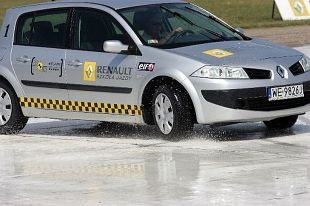
How to drive on ruts?
 In summer, the asphalt heats up to very high temperatures and deforms under the wheels of cars. Deep ruts are formed that can pose a serious safety hazard. Coaches from Renault driving school suggest how to handle the steering wheel when driving on a deformed surface.
In summer, the asphalt heats up to very high temperatures and deforms under the wheels of cars. Deep ruts are formed that can pose a serious safety hazard. Coaches from Renault driving school suggest how to handle the steering wheel when driving on a deformed surface.
Asphalt, heated by the summer sun to a temperature of even 60-70 ° C, can melt and  deform under the wheels of cars. It is not only massive buses and trucks that run over the top layer of the road, contributing to the formation of very deep ruts.
deform under the wheels of cars. It is not only massive buses and trucks that run over the top layer of the road, contributing to the formation of very deep ruts.
Asphalt can be so pliable that it bends under the wheels of all vehicles. The greatest roughness usually occurs on the busiest roads - for example, roads leading from large cities, as well as in places where cars stop for a few minutes, a dent in the surface, i.e. at bus stops and traffic lights.
 Driving in a deep groove can be very dangerous. In a rut, the car rides like it is on rails, - Renault Driving School coaches warn, - Sometimes it is difficult to get out of a deep rut, which makes it difficult, for example, to change lanes smoothly, and it is doubly difficult to go around obstacles. In turn, in case of rain, this can lead to the so-called. aquaplanation, that is, dangerous sliding through the water.
Driving in a deep groove can be very dangerous. In a rut, the car rides like it is on rails, - Renault Driving School coaches warn, - Sometimes it is difficult to get out of a deep rut, which makes it difficult, for example, to change lanes smoothly, and it is doubly difficult to go around obstacles. In turn, in case of rain, this can lead to the so-called. aquaplanation, that is, dangerous sliding through the water.
If the width of the road allows, you should drive near the ruts, along their crests - this is especially important when it rains. However, this is not always possible, especially on narrow city streets. So if you have no choice and need to follow a track, you need to limit your speed. You also need to hold the steering wheel very firmly. He should not make sudden movements or brake sharply, - Renault driving school experts advise - All maneuvers should be smooth and calm. Changing lanes too quickly, such as when overtaking, will result in a skid, as the front wheels will "pop" out of the rut while the rear wheels will remain in the rut. So - although driving on a rut is not very safe - it is better not to go off too abruptly.
The track should not allow to "drive" the car. It has a variable width and at some point it can jerk the wheels a lot, say Renault driving school coaches. and be very careful with other road users.
Deformed road surfaces can also be dangerous for a car. Asphalt ridges protruding above the road are sometimes very high and can damage the car's suspension.
